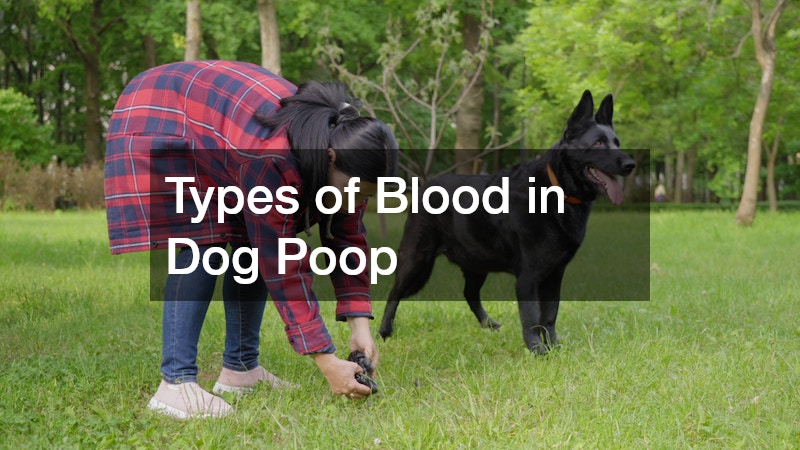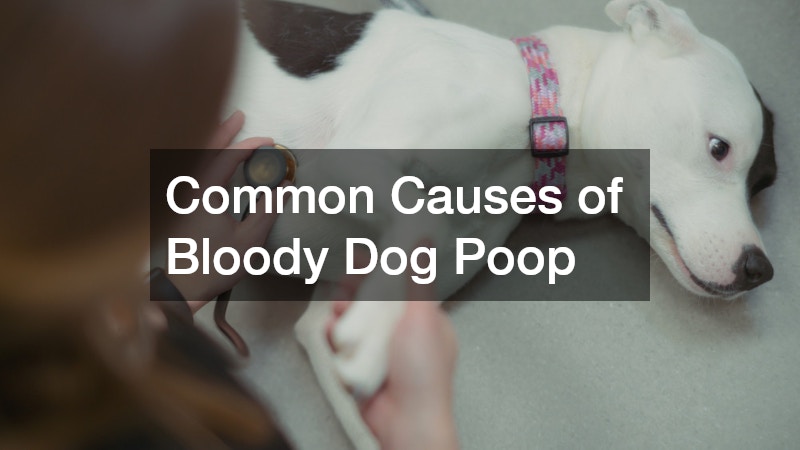Dog Pooping Blood: What It Means & What to Do

Introduction: Why Blood in Dog Poop Is a Big Deal
Seeing blood in your dog’s poop can be scary. It’s not something you should ignore. While sometimes it’s caused by something minor like stress or diet changes, other times it can be a sign of something more serious—like an infection or even internal bleeding.
In this guide, we’ll walk you through:
- What it means if your dog is pooping blood
- The most common causes
- Symptoms to watch out for
- What to do next
- How to help your dog recover
- Ways to prevent this from happening again
Types of Blood in Dog Poop

Not all blood in a dog’s stool looks the same. Identifying the type can help you and your vet better understand what might be wrong and where the issue is coming from inside your dog’s body. There are two main types of bloody stool in dogs: hematochezia and melena. Each one tells a different story about your dog’s health.
1. Hematochezia (Bright Red Blood)
Hematochezia is the presence of fresh, bright red blood in or on your dog’s poop. This kind of bleeding typically comes from the lower digestive tract, such as the colon, rectum, or anus. It may appear as red streaks on formed stool or as drops of blood at the end of a bowel movement.
Common causes of hematochezia include:
- Anal gland problems, like impaction or infection
- Rectal injuries from straining or swallowing something sharp
- Colitis, which is inflammation of the colon and often caused by stress, food intolerance, or infection
- Parasites like hookworms or whipworms, which attach to the gut lining
- Food allergies or sensitivities that irritate the digestive tract
2. Melena (Dark, Tarry Stool)
Melena refers to dark, tarry, or black stools, caused by blood that has been digested as it passes through the digestive system. This usually indicates bleeding in the upper gastrointestinal tract, such as the stomach or small intestine. Melena often has a sticky texture and a strong odor.
Possible causes of melena include:
- Stomach ulcers, often due to medications like NSAIDs
- Internal bleeding from trauma or illness
- Swallowed blood, such as from a nosebleed or mouth injury
- Toxins or drugs that damage the gut lining
- Cancer affecting the stomach or intestines
Understanding the type of blood in your dog’s stool helps guide proper care and treatment.
Common Causes of Bloody Dog Poop

Seeing blood in your dog’s poop can be alarming. While some causes are mild and easy to treat, others can be serious and may require emergency care. Knowing the possible reasons helps you act quickly and protect your dog’s health. Here are the most common causes of bloody stool in dogs:
- Dietary Changes or Eating the Wrong Thing
One of the most common reasons for bloody poop is when a dog eats something they shouldn’t. Dogs often get into the trash or chew on unsafe objects like chicken bones, spoiled food, or even household items. These can irritate or damage the stomach and intestines, leading to bleeding. Even a sudden change in diet can upset their digestive system and cause blood to appear in their stool.
- Infections
Certain infections can damage your dog’s digestive tract and cause bloody diarrhea. These include:
- Parvovirus – a dangerous and often deadly virus, especially in puppies, that causes vomiting, bloody diarrhea, and weakness.
- Bacterial infections – such as Salmonella or E. coli, which come from eating raw or contaminated food.
- Parasites – like Giardia, hookworms, and whipworms, which live in the intestines and cause inflammation and bleeding.
If your dog has bloody diarrhea along with vomiting, fever, or lethargy, contact your vet right away.
- Intestinal Parasites
Worms like hookworms and whipworms attach to your dog’s intestinal walls and feed on their blood. Over time, this can lead to:
- Bloody or tarry stools
- Weight loss
- Pale gums
- Tiredness or weakness
Parasites are common in puppies and dogs that haven’t been dewormed regularly. Stool tests and deworming medications usually solve the problem.
- Stress or Anxiety
Stress doesn’t just affect humans—it can upset your dog’s stomach too. Big changes, like moving to a new home, boarding at a kennel, or bringing home a new pet, can cause a condition called stress colitis. This inflammation of the colon may result in diarrhea with streaks of blood or mucus.
- Food Allergies or Sensitivities
Dogs can have allergic reactions or sensitivities to certain ingredients in their food, such as beef, chicken, dairy, or grains. This can lead to inflammation in the digestive tract, causing bloody or mucus-filled stools. If the problem continues, your vet may suggest an elimination diet to find the cause.
- Trauma or Rectal Injury
If your dog has been straining to poop, swallowed a sharp object, or had recent rectal surgery, they might injure the lining of their intestines or rectum. This can cause bright red blood in or around the stool. Even excessive scooting or licking of the anal area can cause minor bleeding.
- Medications
Some medications, especially nonsteroidal anti-inflammatory drugs (NSAIDs) used for pain or arthritis, can irritate the stomach lining. Over time, this can lead to ulcers or even internal bleeding, which might show up as black, tar-like poop (melena) or visible blood in the stool.
- Toxins or Poisons
If your dog eats something toxic, like rat poison or certain plants, it can interfere with blood clotting and cause internal bleeding. This may lead to bloody vomit or bloody diarrhea. If you suspect poisoning, treat it as an emergency and get your dog to a vet immediately.
- Cancer
Tumors in the digestive system, especially in older dogs, can bleed. While cancer is a less common cause, it’s still something vets will check for if your dog has ongoing bloody stools that don’t improve with treatment. Other signs of cancer may include weight loss, loss of appetite, and fatigue.
Other Symptoms to Watch For
If your dog is pooping blood, it’s important to pay close attention to any other signs of illness. These extra symptoms can give your vet helpful clues about what’s going wrong and how serious the condition might be.
- Diarrhea or loose stools often go hand-in-hand with bloody poop and may suggest infections, parasites, or stomach irritation. If the diarrhea is frequent or watery, it can quickly lead to dehydration.
- Vomiting is another red flag, especially if it happens along with bloody stool. This combination may point to a virus, toxin, or internal bleeding.
- Lethargy or weakness means your dog doesn’t have their usual energy. This can be caused by blood loss, pain, or infection.
- Loss of appetite is common when dogs don’t feel well. If your dog stops eating, it’s a clear sign that something isn’t right.
- Weight loss could mean a long-term issue like parasites or digestive disease, especially if your dog’s eating habits haven’t changed.
- Pale gums may signal internal bleeding or anemia, which is a lack of red blood cells.
- Straining or pain during pooping could mean your dog has constipation, rectal injuries, or inflammation in the colon.
- Fever suggests infection or inflammation in the body.
- Dehydration can happen fast if your dog is vomiting or has diarrhea. Check for dry gums, sunken eyes, or skin that doesn’t bounce back when pinched.
If your dog has any of these symptoms along with blood in their stool, don’t wait—call your vet immediately. Early treatment can make a big difference.
When to Call the Vet
Bloody poop should never be ignored. Call your vet immediately if:
- There’s a large amount of blood
- Your dog is very young, very old, or has other health problems
- The bleeding lasts more than a day
- Your dog also has vomiting, fever, or seems very sick
In these cases, your dog may need emergency care.
What to Expect at the Vet
When you take your dog to the vet, they will ask questions about:
- When the blood started
- What the poop looks like
- Any changes in diet or routine
- Medications or treats
- Other symptoms
Then they may run tests, like:
- A physical exam
- Blood tests
- Stool sample test (to check for parasites or bacteria)
- X-rays or ultrasound
- Endoscopy (in some cases)
The treatment depends on the cause.
Treatment Options
Once your vet knows what’s causing the bleeding, they can start treatment. Here are some common options:
1. Medication
If it’s an infection or inflammation, your vet may prescribe:
- Antibiotics
- Dewormers
- Anti-diarrheal meds
- Probiotics
- Stomach protectants
2. Dietary Changes
Your vet may recommend a bland diet at first—like boiled chicken and rice. Then they might switch your dog to a special hypoallergenic or high-fiber diet.
3. IV Fluids
If your dog is dehydrated, fluids may be given under the skin or through an IV.
4. Surgery
In rare cases, surgery may be needed to remove a tumor or fix an internal injury.
Home Care Tips for Recovery
Once your dog is home, you’ll need to help them recover:
- Follow your vet’s feeding and medication instructions
- Watch for signs of improvement or worsening
- Keep fresh water available at all times
- Don’t give any new treats or table scraps
- Keep your dog calm and rested
How to Prevent Bloody Poop in Dogs
Some causes of bloody poop can’t be prevented, but many can. Here’s how to protect your pup:
1. Feed a Consistent, Balanced Diet
Sudden changes in food can upset your dog’s stomach. Always switch foods slowly over 5–7 days.
2. Keep Your Dog Away from Trash
Garbage and spoiled food can make dogs very sick. Keep trash bins closed and watch your dog on walks.
3. Regular Deworming
Parasites are common in dogs. Ask your vet how often your dog should get dewormed.
4. Vaccinate
Vaccines like the parvovirus shot can prevent serious infections.
5. Limit Stress
Try to keep your dog’s routine consistent. Use calming aids if they’re anxious when you travel or move.
6. Use Medications Carefully
Never give your dog human medications without checking with your vet. Even pet-approved meds can cause issues if used incorrectly.
Should You Be Worried?
Yes—any time your dog is pooping blood, it’s worth getting checked. While some causes are mild and go away quickly, others can be dangerous. Trust your instincts. If something feels off, contact your vet.
What About Bloody Diarrhea?
Bloody diarrhea is a sign your dog’s gut is inflamed or infected. It can lead to dehydration fast—especially in puppies. This needs a vet visit right away. If your dog has both vomiting and bloody diarrhea, they may need emergency care.
What If the Blood Only Happens Once?
If your dog poops a little blood once and seems totally fine otherwise:
- Monitor closely
- Feed a bland diet for a day or two
- Make sure they’re drinking water
If it happens again or your dog seems sick, call your vet.
Conclusion: Don’t Wait—Get Help If Your Dog Poops Blood
If you see blood in your dog’s poop, stay calm but act quickly. Some causes are mild, but others are very serious. Knowing what to look for and when to call the vet can make all the difference.
Always err on the side of caution. Your dog’s health is worth it.
